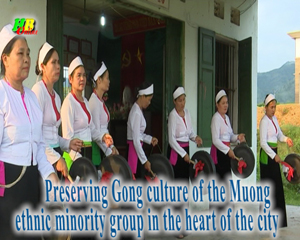
(HBO) - There are 80 households in Group 10, Thinh Lang Ward (Hoa Binh City), and over 90% of the population are the Muong ethnic people. Along with living in the center of the city, economic and cultural exchanges, modern cultural flows have greatly influenced traditional cultural activities. In young children, little could speak the local language of the Group, also women do not know how to play gongs, which make the staff and members of the Group anxious and seek direction to restore the identity. However, there was only one set of gongs in the whole ward which was assigned to Group 9 for management and some of them were old and damaged.
The People’s Committee of Lac Son district held a ceremony on April 28 to receive the provincial relic certificate for the ancient rock carving site at Suoi Co stream, located in My Thanh commune.
A special music show titled "The country is in the fullness of joy” has been held at Hoa Binh Square in Hoa Binh city in celebration of the 50th anniversary of the liberation of the South and national reunification (April 30, 1975–2025).
The People's Committee of Lo Son commune, Tan Lac district, has organised the local annual traditional stream fishing festival on April 19 - 20.
As a land deeply intertwined with human history and Vietnam’s millennia-long journey of nation-building and defence, Hoa Binh is often revered for its epic tales and legends.
Residents of Hoa Binh boast a rich cultural identity, reflected in their unique language, traditional attire, customs, and folk melodies – described as "sweet as honey, clear as a mountain stream.”
Lac Son district’s Vu ban town held the 2025 Truong Kha temple festival on April 12–13 (the 15th–16th days of the third lunar month). Since its revival in 2019, the festival has been organised every three years, preserving valuable intangible heritage while meeting the community’s cultural and spiritual needs.


